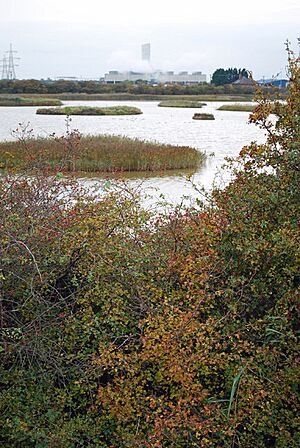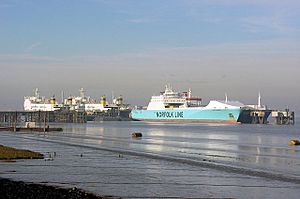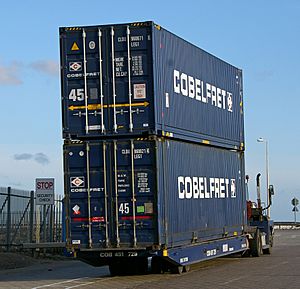North Killingholme Haven facts for kids
North Killingholme Haven is a water outlet on the south bank of the Humber Estuary. It is located in the area of North Killingholme, near the Port of Immingham.
In the early 1900s, this area was used to dig out clay. A jetty was built to send the clay by boat to Kingston upon Hull. Later, in 1912, the British Admiralty (the Royal Navy) was allowed to build a jetty here. This jetty was for shipping fuel oil. During the First World War, a large base for seaplanes, called RNAS Killingholme, operated from here.
In the 1990s, a company called Simon Group built a special port terminal at the Haven. It was named the Humber Sea Terminal. This terminal grew to have six berths (places for ships to dock) through the 1990s and 2000s.
Contents
History of North Killingholme Haven
At the end of the 1800s, North Killingholme Haven was mainly used to drain water from local fields. There was a special gate, called a sluice, where the water flowed into the Humber. Only one building, the New Inn, stood at this water outlet.
Clay Mining and Wildlife Haven
Between 1909 and 1913, a company called Earles Cement used clay from pits at North Killingholme. This clay was sent by barge to their cement works in Hull. Workers first dug the clay by hand. Later, steam engines and small trains helped move it to a jetty at the Haven.
The old clay pits are now filled with water. They have become a special salty lagoon habitat. This area is home to some rare birds and small creatures without backbones.
In 1912, the Royal Navy was given permission to build a pier at the Haven. This pier was very long, about 800 feet (240 m) (244 meters). It had a T-shaped end. By the mid-1910s, the jetty was already receiving oil.
In 1931, another law allowed the Navy to make the pier's end even bigger. This made it an important place for the Royal Navy to refuel its ships. A railway station, called Killingholme Admiralty Platform railway station, served the oil storage site from 1930 to 1963.
RNAS Killingholme: Seaplane Base
Next to the Navy's oil depot, a seaplane base opened in August 1914. It was first called RNAS Immingham but was soon renamed RNAS Killingholme. By late 1914, the base had large hangars for planes and a long slipway for seaplanes to enter the water.
During the First World War, the base grew even more. It got bigger hangars and more slipways. At its peak, about 900 staff worked there, operating over 100 airplanes. It became one of the most important seaplane bases in the UK. After the war ended, the base closed. Some of its hangars were later used to build a bus depot in Grimsby.
Modern Use of the Haven
The area around North Killingholme Haven has been seen as a good place to build more port facilities. In the 1980s, an £80 million port was suggested but not built. However, in the 1990s, the Simon Group did build special "Roll-on/Roll-off" facilities here.
Today (as of 2015), a company called Humber Work Boats Ltd. uses the Haven for dredging work.
Humber Sea Terminal: A Modern Port
In late 1994, the Simon Group got permission to build a jetty at North Killingholme Haven. This new port was designed to be a deepwater terminal for "roll-on/roll-off" ships. These ships carry containers and vehicles from European ports like Rotterdam.
Construction began in 1999. The work included a 143 metres (469 ft) (469 feet) long jetty with two berths. It also had a floating platform, called a pontoon, and a 227 metres (745 ft) (745 feet) pier connecting to the land.
Opening and Expansion
The first part of the terminal, with two berths, opened in June 2000. Stena Line began sailing from here to Hook of Holland. The terminal quickly became very busy.
By 2002, the Simon Group planned to add two more berths. This "Phase Two" was approved in 2003. A contract was given to build a third berth, which included a new 240 metres (790 ft) (787 feet) long jetty. This third berth was finished in February 2004. It was designed for large ships up to 35,000 gross tons and 200 metres (660 ft) (656 feet) long.
The fourth berth was also built as a "roll-on/roll-off" facility. A Belgian shipping company, Cobelfret, signed a 20-year agreement to use it. This fourth berth cost about £8 million to build.
For this second phase of expansion, an extra £14.5 million was spent on land for storage. This covered about 60 acres (24 ha) (24 hectares).
Around 2005, Kia Motors moved its car import operations to a large vehicle import center here. This center was served by the port.
By late 2005, many shipping companies were using the terminal. These included Stena Line, Cobelfret, UECC, Norfolkline, Ferryways, and Eukor. Plans for a third phase of the terminal, adding two more berths, were also underway. A new law in 2006 allowed for a new jetty, pier, and link bridge.
As of 2012, the terminal is owned by C.RO nv through its company C.RO Ports Killingholme Ltd.. The port now has six "roll-on/roll-off" berths. It also has 260 acres (107 ha) (264 acres) of land for future development. The facilities include a center for checking cars before delivery and a railway connection.
Images for kids







